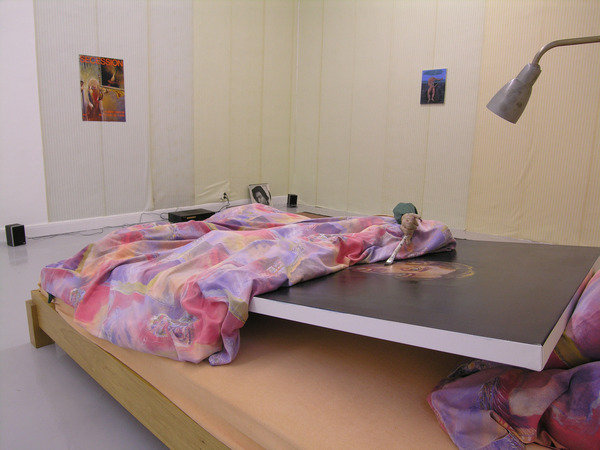Albert Oehlen
dal 6/6/2013 al 19/10/2013
Segnalato da
6/6/2013
Albert Oehlen
Museum Moderner Kunst MUMOK, Wien
Malerei. With more than 80 paintings, collages, computer prints, drawings, and an untitled installation from 2005, this is the hitherto largest presentation of Oehlen's highly diverse oeuvre. The exhibition design compares and contrasts different groups of works, which are involved in a permanent 'dispute of ideas'.

curated by Achim Hochdörfer
From June 8 to October 20, the exhibition Albert Oehlen. Malerei will present the first
comprehensive overview in Austria of Oehlen’s work from the early 1980s to the
present, including key works from all phases of the artist’s career. With more than 80
paintings, collages, computer prints, drawings, and an untitled installation from
2005, this is the hitherto largest presentation of Oehlen’s highly diverse oeuvre.
“This is the first opportunity to see such a large range of Oehlen’s work in one
place,” says director Karola Kraus. The exhibition design compares and contrasts
different groups of works, which are involved in a permanent “dispute of ideas”
(Albert Oehlen). These various groups will transfer energy to and from, commenting
on and questioning each other. The exhibition will also show for the first time a new
four-part cycle, in which Oehlen programmatically refers collage techniques and
actionist finger painting to each other.
Albert Oehlen (born 1954 in Krefeld) is not only one of the most influential, but also
one of the most controversial of contemporary painters. His project of bringing
painting up to date consists not least in positioning this good old medium against its
critics and often naive supporters alike. He aims to bring painting into conflict on
several fronts at the same time—with its own history, with its clichés and its missed
opportunities, and with the ubiquitous power of the pictorial languages of advertising
and pop. Oehlen wishes to restore freshness and complexity to a medium that has
been declared defunct, not by dodging all the attacks and polemic to which tradition
is subjected, but by making the picture itself the locus of lively debate on these
issues.
“It is as if Oehlen were continually out-tricking painting. The intrinsic and extrinsic
enemies of painting—avant-garde and new technologies—are brought into the
picture, and clichés like beauty or virtuosity are smuggled in cunningly,” says curator
Achim Hochdörfer about Oehlen’s painterly strategy.
Oehlen’s initial turn to painting in the 1980s was characterized by restrictions,
impertinence, and the politically incorrect. He concentrated on certain colors (mostly
drab browns), hackneyed symbols (such as the mirror), and themes that were
ideologically negative (like the self-portrait). These were tactical steps with which
Oehlen, who now lives in Switzerland, drew painting into embarrassing situations.
This kind of polemic was not least directed at all the countless stop signs and dead
ends that modernist painting had been increasingly confronted with since the
1960s. Oehlen blurs the neat dividing lines between traditional and progressive art,
between good and bad, and between reactionary and critical. In his monumental
Mirror Paintings of the mid-1980s, he overlaps different concepts of space, for
example: color surfaces, perspectivist space, and mirrored real space combine to
create dark and beautiful scenarios.
Post-non-representational Painting
In the late 1980s, Oehlen coined the term “Post-non-representational Painting” as a
way of describing his basic conceptual approach. Programmatically speaking, his
aim was to deconstruct the oppositions between figurative and non-figurative, figure
and background, and color and line. The polemical jabs that had been spread across
various groups of work in Oehlen’s early oeuvre now seemed to be brought into the
picture itself. In mostly very large tableaux Oehlen developed a sheer inexhaustible
arsenal of painterly signs, as figurative, narrative, abstract, and collage elements all
speak simultaneously with and against each other. Here Oehlen’s painting turns
against the dictates of purity in reductionist modernism, which saw itself in a
permanent process of shedding extraneous, non-artistic elements. But Oehlen did
not abandon painting—his excursions into pop culture, advertising, trash and
computer aesthetics, and into political iconography, are always strictly bound up
within the larger context of the composed and painted picture. To this day, Oehlen
remains true to this principle. In a series from 2010 to 2012, which has not yet been
presented to the public, he links expressive painting with collage elements and
confronts art-historical points of reference (to DADA, for example) with the garish
trash of the culture industry.
This Vienna exhibition uses a deliberately confrontational design and hanging of
Oehlen’s groups of works so as to highlight his critical approach to the medium of
painting, thereby allowing the works to critically question each other.
Catalogue
The exhibition catalogue also takes a productive approach to Oehlen’s painting. As
well as an interview between Albert Oehlen and Daniel Richter, the catalogue
contains controversial conversations between Rochelle Feinstein and Kerstin
Stakemeier, and between Hal Foster and Achim Hochdörfer. The graphic design by
Heimo Zobernig is based on the “systematic production of mistakes.” It reminds us
that the reception of Oehlen’s painting has also been a process full of conflict, in
which attacks, doubts, and cunning interventions all played a role.
Image: Ohne Titel, 2005
(Untitled)
1 Leinwand unfertig, 170 x 110 cm; Bett 205,5 x 145,5 cm; Teppich 300 x 200 cm; Bettzeug; Nachttopf;
Plattenspieler; Stereoanlage klein; LPs; Eimer mit Pinsel; persönliche Effekte/ Unfinished canvas, 170 x 110
Cm; bed 205,5 x 145,5; carpet 300 x 200 cm; bed linen; chamber pot; record player; audio equipment; LPs;
bucket with paint brush; personal effects
Maße variabel/dimensions variable
Photo: Courtesy Galleria Juana de Aizpuru, Madrid
© Albert Oehlen
Press contact
Karin Bellmann
T +43 1 52500-1400
karin.bellmann@mumok.at
Barbara Hammerschmied
T +43 1 52500-1450
barbara.hammerschmied@mumok.at
press@mumok.at
www.mumok.at/presse
Press conference: June 7, 2013, 10 am
Opening: June 7, 2013, 7 pm
mumok
Museumsplatz 1, 1070 Vienna
Opening hours Monday: 2–7 pm
Tuesday to Sunday: 10 am–7 pm
Thursday: 10 am–9 pm
Entrance prices Normal € 10
Concessions € 8 or € 7



